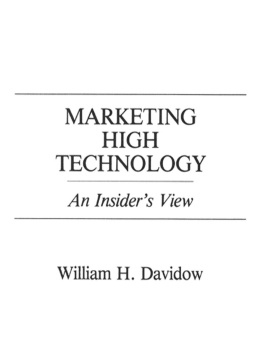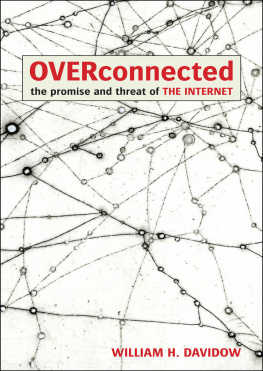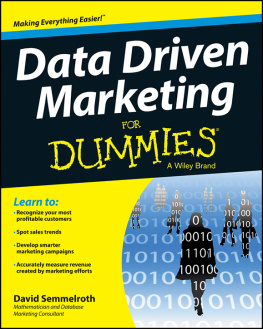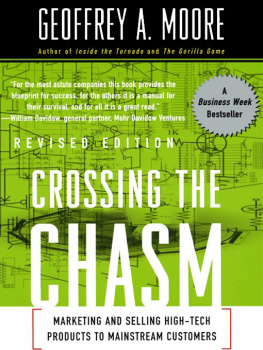MARKETING
HIGH
TECHNOLOGY

THE FREE PRESS
A Division of Simon & Schuster Inc.
1230 Avenue of the Americas
New York, N.Y. 10020
www.SimonandSchuster.com
Copyright 1986 by William H. Davidow
All rights reserved, including the right of reproduction in whole or in part in any form.
THE FREE PRESS and colophon are trademarks of Simon & Schuster Inc.
Manufactured in the United States of America
Library of Congress Cataloging-in-Publication Data
Davidow, William H.
Marketing high technology.
Includes index.
1. High technologyMarketing. 2. Marketing. I. Title.
HC79.H53D38 1986 621.381 7 0688 85-28061
ISBN 0-02-907990-X
ISBN: 978-0-0290-7990-4
eISBN: 978-1-4391-0755-3
To Sonja the Perceiver, Carolyn the Creator, and Becky the Analyzer, whose support, ideas, and insights have helped so much
 Contents
ContentsAppendix B. How Costs and Margin Goals
Affect Price
 FOREWORD
FOREWORDMANY YEARS AGO, I found myself managing a computer businessthe largest, fastest growing, and most profitable division of the Hewlett-Packard Companyand loving the challenge but being frustrated by the brutal competition from my sixteen sister divisions for marketing and other resources. The internal competition made the external competitors DEC and Data General look mild. Being outspoken, I complained at length to Bill Hewlett about the lack of a corporate strategic marketing plan. Some little while later, I found myself assigned to him to solve this exact problem.
While I had been vocal in identifying the problem, when the task became mine I had few ideas on where to begin to solve it. At the beginning, the Boston Consulting Groups newly formulated theories of market share strategy enabled me to tackle effectively the problem I faced, but as I learned in practice, those theories were only a beginning.
In the years since then, the experience curve, the cash cow, and the other early theories of market share strategy of BCG have been widely used, more widely abused, and have become a part of business folklore. Good theory is in very short supply in the business world, particularly in marketing, where all too often decisions are made subjectively.
But those market share concepts, while correct (if properly applied), are incomplete. Theyre similar to Newtons laws of motion, which are valid but cover only limited situations. The genius of Einstein was needed to express adequately a general theory. Thats what Bill Davidow has done for marketing in this remarkable book.
Drawing from examples as diverse as a Rolling Stones concert and a microprocessor chip, his definition of a true product is both obvious and fundamental. Similarly, ideas for true customer service and the imperative for it are developed. The strategic importance of distribution as it relates to market sector, pricing and the pitfalls it entails, and all the other basics of marketing are analyzed and explained in new ways. These ways build upon the earlier market sector and market share ideas, achieving a synthesis and unity not found elsewhere.
In our era, where devices can be assembled quickly from product genes to enter an incredibly crowded market, where simultaneously there can be distribution channel voids and overlaps, where confusion and grid-locked communications are the norm, and where the financial stakes are tremendous, clear new marketing theory is badly needed. Bill Davidow makes this contribution.
I first met the author in the computer wars at Hewlett-Packard, during the time when he was making the transition from Dr. Davidow, computer scientist, to Bill Davidow, sales superstar and topflight marketeer. It is a pleasure now to read this book, which is so rich in personal experience developed in high-tech marketing top management over two decades. But more important, Bill has made a valuable and enduring contribution to the science of marketing.
This is a badly needed contribution, for marketing inefficiency, with all its raminifactions, is appallingly wasteful. Products that fail consume resources in a nonuseful way. There is nothing healthy about competitive death in the market place; both manufacturers and customers lose. What good to anyone is an abandoned home computer gathering dust in the attic? The many me too products and even me too companies that follow every true innovation dont advance the state of the art; on the contrary, they drain resources from the leaders, rendering everyone more vulnerable to outside competitors such as the wily Japanese. This is true in markets as diverse as semiconductors, genetic engineering, and home entertainment products.
Davidow writes about successful product crusades. Indeed, he is a crusader here, but for all marketing, for all companies: a tough challenge but one handled masterfully. This book should be required reading not only for marketeers, but for all those who depend upon successful new productsfrom engineers to financiers. Im glad Bill took the time to make his ideas and insights available to us all.
Thomas J. Perkins
San Francisco
 Acknowledgements
AcknowledgementsTHE QUALITY AND READABILITY of this book have been greatly influenced by the efforts of three individuals. Russ Berg, a close friend and a marketing genius, spent a great deal of his time reading and critiquing the manuscript. He contributed a number of valuable ideas. Michael S. Malone edited and helped to rewrite significant portions of the text, making it more readable and immeasurably improving its flow. Bob Wallace, my editor at The Free Press, supported the effort and greatly helped in structuring the manuscript.
All through my life I have been fortunate to have wonderful teachers who have shaped much of my thinking and influenced my actions.
Leonard Davidow, my father, spent much time introducing me to both advertising and promotions.
Theodore Levitt, whom I met first through his articles and books, really is responsible for my selection of marketing as a career and much of my success.
Regis McKenna, a close working associate, taught me a great deal about advertising and public relations.
Tom Perkins, whom everyone thinks of as a venture capitalist, was my first real on-line instructor and a very good one at that.
Franco Mariotti was the first to teach me about international markets.
My friends and associates at Intel have contributed greatly. Andy Grove, its president, really sharpened my management skills, which became a key in marketing successes. If anyone can teach someone how to run a management crusade, he can. Ed Gelbach spent innumerable hours adding reality therapy to my theoretical approaches.
My last staff at Intel were wonderful teachers as well. Tom Kamo and Bernard Giroud added immeasurably to my understanding of international markets. Carlene Ellis and Jim Grenier taught me about service. Frank Gill and Bob Derby contributed greatly to my insights about sales and distribution. Ron Whittier taught me how to make planning in marketing effective. Dick Abascal demonstrated time and time again the value of financial analysis in marketing.
Next page









